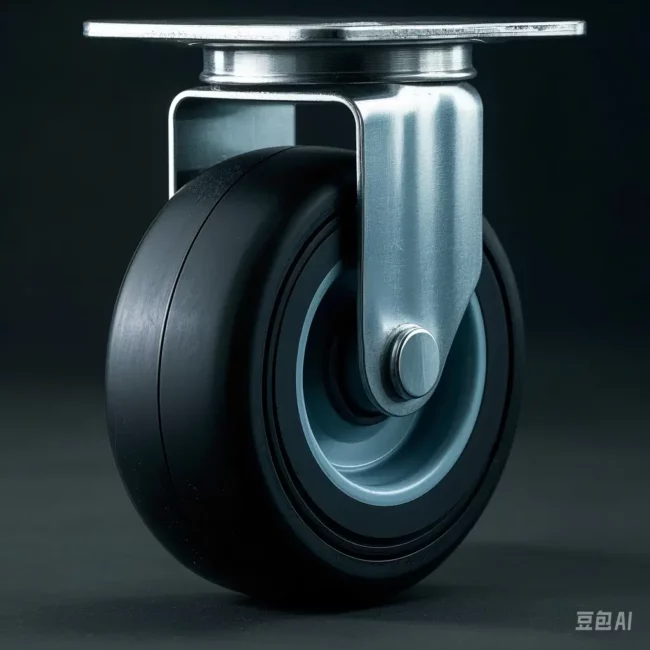For Grip Ring Stem Casters
-
Remove the old caster and measure its length and diameter for selecting a compatible replacement.
-
Choose a new heavy-duty caster with a grip ring.
-
Use pliers to pull the old caster out of the socket or insert.
-
Apply force to push the new caster into the grip ring insert or socket until it snaps into place.
-
Perform a gentle tug or shake test to ensure the caster remains securely attached.
For Threaded Stem Casters
With Inserts
-
Remove the old caster and measure the length and diameter.
-
Select a replacement threaded stem caster that matches the threading and fits securely.
-
Screw the new caster into a threaded insert using a wrench or other suitable tool.
-
Ensure the caster is tightly fastened to maintain stability during use.
With Lock Nuts
-
Remove the lock nut, lock washer, and threaded stem caster from the old installation.
-
Determine the diameter needed for the replacement caster.
-
Insert the new threaded stem caster through the hole and place the lock washer and lock nut on top.
-
Use a wrench or appropriate tool to securely tighten the caster.
For Top Plate Casters
-
Prepare the surface and structure to ensure it is rigid enough to support the load.
-
Position the top plate on the structure and mark the hole positions with a pencil.
-
Drill pilot holes using a drill bit that is approximately 50% the diameter of the bolt.
-
Mount the casters by aligning the holes and screwing them into place.
-
Check the mobility by testing the equipment to ensure all wheels function properly and make full contact with the floor.
For Post or Stem Casters
-
Mark the positions for each caster on the furniture leg or structure.
-
Drill a hole that matches the diameter of the caster stem.
-
Insert the caster stem into the hole and gently tap it into place with a rubber mallet.
-
Ensure the caster is secure and does not wiggle.
For Swivel Caster Wheels
-
Inspect the mounting surface for debris or irregularities.
-
Position the swivel caster wheels at the designated points.
-
Mark the mounting holes and drill them if necessary.
-
Secure the casters using bolts and a wrench.
-
Test the wheels to ensure smooth movement and swiveling.
Tools Needed
-
Drill
-
Wrench
-
Pliers
-
Measurement tools (tape measure or ruler)
-
Screwdriver
-
Rubber mallet
Make sure to choose the right type of caster wheels based on the load capacity, wheel size, and fixing method suitable for your specific application.
Can I replace the caster wheels with larger ones?
Compatibility and Fit
-
Measurements: Before replacing the caster wheels, measure the diameter and width of the current wheels, as well as the mounting height (the distance from the bottom of the wheel to the top of the plate where the caster wheel attaches) . Larger wheels may affect the height and stability of the equipment.
-
Mounting Type: Ensure that the new larger wheels have the same mounting type (e.g., threaded stem, grip ring, top plate) as the original wheels to fit properly .
Load Capacity
-
Weight Distribution: Larger wheels can often support more weight, but you need to ensure that the new wheels meet or exceed the required load capacity for your equipment. Calculate the load capacity by adding the weight of the equipment and the maximum load it will carry, then dividing by the number of casters. Apply a safety factor based on the intended use conditions (e.g., indoor manual transport, outdoor power-driven transport) .
-
Weight Distribution: If you replace the wheels with larger ones, ensure that the weight is evenly distributed to avoid instability .
Functionality and Mobility
-
Swivel and Maneuverability: Larger wheels may improve the mobility and swivel capabilities of the equipment, but they must be properly aligned and installed to ensure smooth operation. Test the wheels after installation to ensure they swivel and move without wobbling or resistance .
-
Floor Surface: Consider the type of floor surface where the equipment will be used. Larger wheels may be more suitable for rough or uneven surfaces, but they should not damage the floor .
Installation and Safety
-
Secure Installation: Follow the manufacturer’s instructions for installing the new wheels. Use the appropriate tools and ensure that all bolts or screws are tightened securely but not overtightened .
-
Safety Equipment: Wear appropriate personal protective equipment (PPE) such as gloves and safety glasses during installation to prevent injuries .
Maintenance
-
Regular Inspection: After replacing the wheels, continue to inspect them regularly for signs of wear or damage. Lubricate moving parts as needed to maintain smooth operation .
By carefully considering these factors, you can successfully replace your caster wheels with larger ones to enhance the functionality and durability of your equipment.





